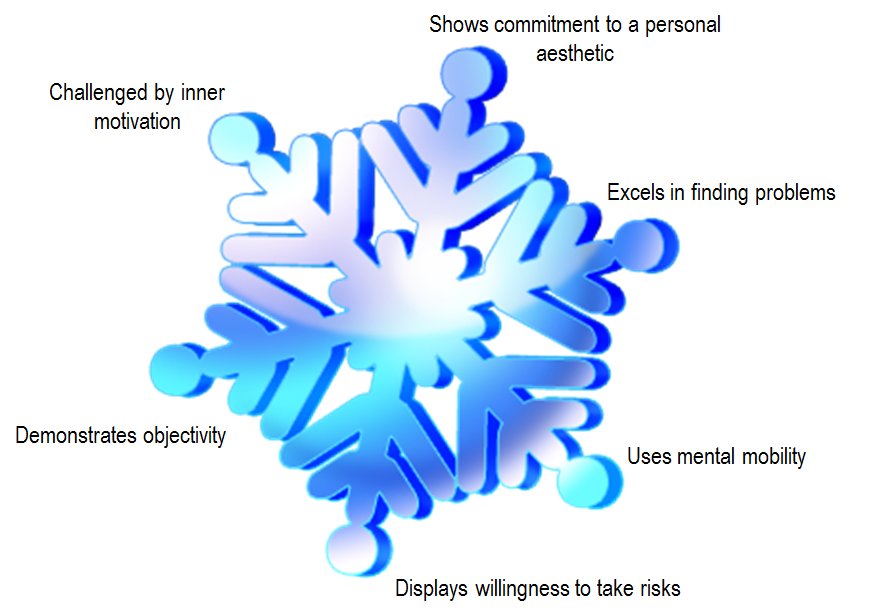Creativity concerns what we do with our abilities.
David Perkins The mind’s best work
The Snowflake Model of Creativity – Differentiating creative people from others using David Perkins’ Six-Trait Model
Using the snowflake structure as a visual metaphor, Perkins’ six trait model of creativity is easy to remember and understand while still being an accurate description of the things that differentiate highly creative people from others. The model consists of the following elements:
1. A strong commitment to a personal aesthetic. Creators have a high tolerance for complexity, disorganization, and asymmetry. They enjoy the challenge of struggling through chaos and struggling toward a resolution and synthesis.
2. The ability to excel in finding problems. Scientists value good questions because they lead to discoveries and creative solutions, to good answers.
3. Mental mobility allows creative people to find new perspectives on and approaches to problems. Creative people have a strong tendency to think in opposites or contraries. They often think in metaphors and analogies and challenge assumptions as a matter of course.
4. A willingness to take risks and the ability to accept failure as part of the creative quest. These people also exhibit the ability to learn from their failures. By working at the edge of their competence, where the possibility of failure lurks, mental risk-takers are more likely to produce creative results.
5. Creative people not only scrutinize and judge their ideas or projects, they also seek criticism. Objectivity involves more than luck or talent; it means putting aside your ego, seeking advice from trusted colleagues, testing and retesting your ideas. Personal objectivity and self-reflective behaviors, especially about work or creations, are very hard to carry off well and require folks to distance themselves and then look at themselves and their creations for a distance. Objectivity is something very hard to achieve.
6. The last trait is that of inner motivation. Creators are involved in an enterprise for its own sake, not for school grades or paychecks. Their catalysts are the enjoyment, satisfaction, and the challenge inherent in the work itself.
David Perkins is a professor at Harvard and one of the co-founders of Project Zero in Harvard’s Graduate Degree in Education programs. He is the author of numerous books on education, schools, thinking, and creativity.

____________________________________
Other references to Perkin’s Snowflake Model.
A very brief overview of the Model from Harvard’s pages
A conversation with David Perkins on Creativity from the ASCD archives
____________________________________
David N. Perkins’ doctorate is from MIT. For many years he has been on the faculty of Harvard. Along with Howard Gardner he is a founding member of Harvard University’s Project Zero. This organization is tied to Harvard’s Graduate School of Education and investigates human’s symbolic capacities, as well as their cognitive development. Currently he is Project Zero’s senior co-director, as well as a member of the Project’s steering committee. Dr. Perkins continues to conduct research on “creativity, informal reasoning, problem solving, understanding, individual and organizational learning, and the teaching of thinking skills.”
Some of the books by Professor Perkins are:
- (1995) Smart Schools #ad
- (1995) Outsmarting IQ: The Emerging Science of Learnable Intelligence #ad
- (2010) Making Learning Whole: How Seven Principles of Teaching Can Transform Education (1st Edition) #ad
- (2014) Future Wise: Educating Our Children for a Changing World (1st Edition) #ad
**For my readers’ convenience throughout this site I have placed hotlinks for a wide variety of books. By an agreement between Amazon and the United States FTC, I am required to tell my readers that if you use these hotlinks to purchase linked materials from Amazon, then I receive a very, very, very small commission which I use toward my hosting fees.
